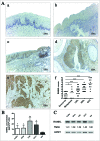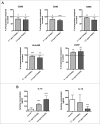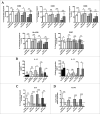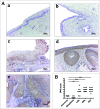Cervical (pre)neoplastic microenvironment promotes the emergence of tolerogenic dendritic cells via RANKL secretion
- PMID: 26155412
- PMCID: PMC4485731
- DOI: 10.1080/2162402X.2015.1008334
Cervical (pre)neoplastic microenvironment promotes the emergence of tolerogenic dendritic cells via RANKL secretion
Abstract
The progression of genital human papillomavirus (HPV) infections into preneoplastic lesions suggests that infected/malignant cells are not adequately recognized by the immune system. In this study, we demonstrated that cervical/vulvar cancer cells secrete factor(s) that affect both the maturation and function of dendritic cells (DC) leading to a tolerogenic profile. Indeed, DC cocultured with cancer cell lines display both a partially mature phenotype after lipopolysaccharide (LPS) maturation and an altered secretory profile (IL-10high and IL-12p70low). In addition, tumor-converted DC acquire the ability to alter T-cell proliferation and to induce FoxP3+ suppressive T cells from naive CD4+ T cells. Among the immunosuppressive factors implicated in DC alterations in genital (pre)neoplastic microenvironment, we identified receptor activator of nuclear factor kappa-B ligand (RANKL), a TNF family member, as a potential candidate. For the first time, we showed that RANKL expression strongly increases during cervical progression. We also confirmed that RANKL is directly secreted by cancer cells and this expression is not related to HPV viral oncoprotein induction. Interestingly, the addition of osteoprotegerin (OPG) in coculture experiments reduces significantly the inhibition of DC maturation, the release of a tolerogenic cytokine profile (IL-12low IL-10high) and the induction of regulatory T (Treg) cells. Our findings suggest that the use of inhibitory molecules directed against RANKL in cervical/vulvar (pre)neoplastic lesions might prevent alterations of DC functionality and represent an attractive strategy to overcome immune tolerance in such cancers.
Keywords: LC, Langerhans cells; LPS, lipopolysaccharide; APC, antigen presenting cells; DC, dendritic cells; GILZ, glucocorticoid-induced leucine zipper; HPV, human papillomavirus; HSIL, high grade intraepithelial lesions; IHC, immunohistochemistry; ILT3, Immunoglobulin-like transcript 3; KN, normal keratinocytes; LSIL, low grade intraepithelial lesion; MFI, mean fluorescence intensity; OPG, osteoprotegerin; PBMC, peripheral blood mononuclear cells; pDC, plasmacytoid dendritic cells; RANKL; RANKL, Receptor activator of nuclear factor kappa-B ligand; SCC, squamous cell carcinoma; SIL, squamous intraepithelial neoplasia; Treg cells; Treg cells, regulatory T cells; VIN, vulvar intraepithelial neoplasia; cervical cancers; dendritic cells; tolerogenicity.
Figures






Similar articles
-
HMGB1 secretion during cervical carcinogenesis promotes the acquisition of a tolerogenic functionality by plasmacytoid dendritic cells.Int J Cancer. 2015 Jul 15;137(2):345-58. doi: 10.1002/ijc.29389. Epub 2014 Dec 27. Int J Cancer. 2015. PMID: 25492101
-
Osteoprotegerin expression in dendritic cells increases with maturation and is NF-kappaB-dependent.J Cell Biochem. 2007 Apr 15;100(6):1430-9. doi: 10.1002/jcb.21129. J Cell Biochem. 2007. PMID: 17171649
-
High expression of PGE2 enzymatic pathways in cervical (pre)neoplastic lesions and functional consequences for antigen-presenting cells.Cancer Immunol Immunother. 2009 Apr;58(4):603-14. doi: 10.1007/s00262-008-0584-4. Epub 2008 Sep 19. Cancer Immunol Immunother. 2009. PMID: 18802697 Free PMC article.
-
The role of interleukin 10 in human papilloma virus infection and progression to cervical carcinoma.Cytokine Growth Factor Rev. 2017 Apr;34:1-13. doi: 10.1016/j.cytogfr.2017.03.002. Epub 2017 Mar 23. Cytokine Growth Factor Rev. 2017. PMID: 28365229 Review.
-
RANK-RANKL Signaling in Cancer of the Uterine Cervix: A Review.Int J Mol Sci. 2019 May 2;20(9):2183. doi: 10.3390/ijms20092183. Int J Mol Sci. 2019. PMID: 31052546 Free PMC article. Review.
Cited by
-
Bispecific Antibodies Progression in Malignant Melanoma.Front Pharmacol. 2022 Mar 23;13:837889. doi: 10.3389/fphar.2022.837889. eCollection 2022. Front Pharmacol. 2022. PMID: 35401191 Free PMC article. Review.
-
Solitary skull metastasis in presumed early stage cervical cancer.Gynecol Oncol Rep. 2021 Nov 13;38:100889. doi: 10.1016/j.gore.2021.100889. eCollection 2021 Nov. Gynecol Oncol Rep. 2021. PMID: 34926769 Free PMC article.
-
Epigenetic modulations of immune cells: from normal development to tumor progression.Int J Biol Sci. 2023 Oct 2;19(16):5120-5144. doi: 10.7150/ijbs.88327. eCollection 2023. Int J Biol Sci. 2023. PMID: 37928272 Free PMC article. Review.
-
Deciphering the Multifactorial Susceptibility of Mucosal Junction Cells to HPV Infection and Related Carcinogenesis.Viruses. 2017 Apr 20;9(4):85. doi: 10.3390/v9040085. Viruses. 2017. PMID: 28425968 Free PMC article. Review.
-
Multiple influence of immune cells in the bone metastatic cancer microenvironment on tumors.Front Immunol. 2024 Feb 23;15:1335366. doi: 10.3389/fimmu.2024.1335366. eCollection 2024. Front Immunol. 2024. PMID: 38464516 Free PMC article. Review.
References
-
- Ellerbrock TV, Chiasson MA, Bush TJ, Sun XW, Sawo D, Brudney K, Wright TC Jr. Incidence of cervical squamous intraepithelial lesions in HIV-infected women. JAMA 2000; 283:1031-7; PMID:; http://dx.doi.org/10.1001/jama.283.8.1031 - DOI - PubMed
-
- Nakamura T, Shima T, Saeki A, Hidaka T, Nakashima A, Takikawa O, Saito S. Expression of indoleamine 2, 3-dioxygenase and the recruitment of Foxp3-expressing regulatory T cells in the development and progression of uterine cervical cancer. Cancer Sci 2007; 98:874-81; PMID:; http://dx.doi.org/10.1111/j.1349-7006.2007.00470.x - DOI - PMC - PubMed
-
- Giannini SL, Hubert P, Doyen J, Boniver J, Delvenne P. Influence of the mucosal epithelium microenvironment on Langerhans cells: implications for the development of squamous intraepithelial lesions of the cervix. Int J Cancer 2002; 97:654-9; PMID:; http://dx.doi.org/10.1002/ijc.10084 - DOI - PubMed
-
- Nakayama Y, Asagoe K, Yamauchi A, Yamamoto T, Shirafuji Y, Morizane S, Nakanishi G, Iwatsuki K. Dendritic cell subsets and immunological milieu in inflammatory human papilloma virus-related skin lesions. J Dermatol Sci 2011; 63:173-83; PMID:; http://dx.doi.org/10.1016/j.jdermsci.2011.05.006 - DOI - PubMed
-
- Gottfried E, Kreutz M, Mackensen A. Tumor-induced modulation of dendritic cell function. Cytokine Growth Factor Rev 2008; 19:65-77; PMID:; http://dx.doi.org/10.1016/j.cytogfr.2007.10.008 - DOI - PubMed
Publication types
LinkOut - more resources
Full Text Sources
Research Materials
